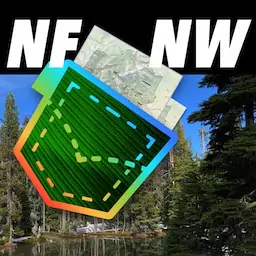Alaska Burn MorelsUSFS Alaska |
Brochure about Alaska Burn Morels. Published by the U.S. Forest Service (USFS).
featured in
| Alaska Pocket Maps |  | |
| National Forests Northwest |  |
United States Department of Agriculture
Alaska Burn Morels
Most morels in Alaska grow in recently burned areas,
with the greatest abundance typically found in the
springtime, 1-3 years after a fire.
Harvesting morels in recently burned areas can be
hazardous. Be aware of unstable trees, ash pits with
active embers, and slippery soils. It’s easy to get lost
in burn areas, so carry a GPS or compass. Bears are
active and hungry in the spring: make noise and carry
deterrents. Be Bear Aware.
Morels resemble other closely related species
frequently found in similar habitats. These run the
True Morels
gamut from choice to deadly poisonous, so learning to
identify true morels from “false” morels is critical. Any
edible in this group should always be well-cooked. Raw and undercooked specimens are responsible for a large
number of poisonings each year.
!
True Morels (Morchella spp.) can vary in color. Typically those
found in burn areas are dark brown, gray, or black. They have conic
to rounded caps with a network of ridges and pits, are completely
hollow, and a cap that is attached along its entire length to the
stem. Morels are considered choice edibles Some people cannot
tolerate morels even when well-cooked.
Early False Morel (Verpa bohemica) can be very common in the
spring, especially among alder and cottonwood. Its cap is
bell-shaped, brown and wrinkled, and is only attached at the top
of the stem. The stem is thick and white, and stuffed with fine
cottony threads. Although commonly collected, this mushroom
can cause gastric upset.
!
Early False Morel
Spring False Morels (Gyromitra esculenta) are frequently found
in burn and natural areas when true morels are also out. The caps
of this false morel are irregular to slightly lobed or saddle shaped
with a brain like surface that varies from dull red to reddish brown
or darker brown. The interior is folded, with one or more chambers.
This mushroom can cause serious illness and death.
Find out more about harvesting morels
Spring False Morels
The Alaska Interagency Coordination Center (fire.ak.blm.gov) has
updated fire information including fire history maps. The University
of Alaska Fairbanks Cooperative Extension Service (cespubs.uaf.
edu) has a useful publication about morels.
Be aware of land ownership as rules with regards to personal or commercial morel harvesting varies by land
owner or land management agency.
all photos ©Noah Siegel
Forest
Service
Alaska
Region
Chugach
National Forest
fs.usda.gov/chugach
May
2020


